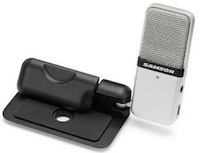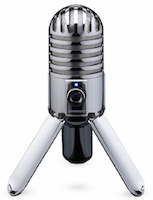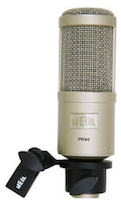 I’m a member of a Google Plus Community called Podcasting Technology Resources which is super active with nearly 2000 members. It’s a great place to talk about gear and tools. Many early podcasters ask me what mic they should get, and that question gets asked really often in the Podcasting G+ community as well. The answer is almost always the Audio-Technica ATR2100. Once one person recommends it, a lot more people chime in also recommending this mic.
I’m a member of a Google Plus Community called Podcasting Technology Resources which is super active with nearly 2000 members. It’s a great place to talk about gear and tools. Many early podcasters ask me what mic they should get, and that question gets asked really often in the Podcasting G+ community as well. The answer is almost always the Audio-Technica ATR2100. Once one person recommends it, a lot more people chime in also recommending this mic.
There are a couple of remarkable things about the ATR2100. First of all, it’s listed for only $55 right now on Amazon. Second of all it supports both XLR and USB. If you have a fancy pants mixer, you can use the ATR2100, but if you just want to plug it right into your computer, you can do that via USB. Those two things make it attractive, and when you combine that with the masses in the Podcasting community also endorsing it, I had to try one out.
I thought it would be fun to do a fly off of several mics. I use a Heil PR40 which is a very high end mic that Steve bought for me one year, I think so he could inherit my Heil PR20. I also have a couple of travel mics that I like to use, the Samson Meteor Mic and the Samson Go Mic. If you’ve been listening to the show you’ve heard reviews of them in the past. Finally I thought for grins and giggles I’d record with the internal mic on my 2014 MacBook Pro as well. I figured this would give a broad range of options from free to just under $400 for a new podcaster to make a decision on how much money they needed to spend.
I started at the low end with the internal microphone working my way up in cost. I included the internal microphone not because I think it’s a viable option but rather for people to hear how awful it sounds vs. spending just a few dollars to get a real microphone. I recorded in GarageBand and didn’t change any settings on the Mac between recordings. I first said the name of the mic and the price, and then recorded myself saying the beginning of my introduction. Next I clipped out just the intro sentence and played them all back to back so you could really compare them.
If you’re listening to this as part of the podcast, you might want to go over to the blog post for this section because I’ve included a table with images of each microphone and a link to them on Amazon. It might help you to categorize them in your head while you’re listening.
Let’s listen to the recording and then I’ll come back and then we’ll chat about it.
Audio PlayerWhile listening to the comparisons in GarageBand, the Audio-Technica ATR2100 sounded pretty close to the PR40, but the version you’re hearing has been sampled down to a 64kbps mp3, and the slight crunchiness in the ATR2100 is more evident. I do think that for 1/5th the cost, it’s AMAZING. The Heil PR20 performed very well and at less than half the cost of the PR40 it’s a great option, but don’t forget you still have to shell out for a USB interface if you’re not going to use a mixer.
If you’re starting in podcasting, I can definitely recommend the Audio-Technica ATR2100 for a mere $60. Keep an eye out, it sometimes drops as low as $45!
Samson Go Mic
|
 |
Samson Meteor Mic
|
 |
Audio-Technica ATR2100
|
 |
Heil PR-20
|
 |
Heil PR-40
|
 |

Thank Allison, this is a really helpful comparison. I recently added the Audio Technica AT2005USB to my mic collection (I understand that this has the same capsule as the ATR2100) and am quite impressed. It isn’t perfect, but pretty impressive for around $50.
I’ve heard about the other ATR models, Curtis. Seems they’ve come out with several really good (while not great) mics at surprisingly low prices. Glad to know the 2005 is working well for you.
Wow, that Audio-Technica ATR2100 is a good microphone. Thank you for the audio recording to demonstrate it so clearly!
That’s a great deal.
I have the Audio-Technica AT2020USB Cardioid Condenser USB Microphone which is currently $129 on Amazon. And does not have XLR.
I was going to comment that the $70 price difference paid for a stand that would be extra, but down lower on the Amazon Page it’s clear the $59 mic also comes with a stand.
There must be some reason the one I bought cost $70 more. Please?
I’m wondering the same thing, too, @George. I also have the AT2020, like you, but the XLR version and was thinking of getting a USB/XLR mic like the Blue Yeti Pro which is about $200. I’m wondering about the differences in price on all these and what the reasoning is.
Thanks for this comparison!
I should clarify one thing: The AT2005 (same capsule as the ATR2100) sounds good when recorded via XLR into a quality pre-amp/audio interface. It does not sound nearly as good using the in-built interface via USB directly to computer. They clearly use a rather inexpensive, relatively low quality preamp/analog to digital converter in the mic. Although I have not used the Blue Yeti, I suspect that it may be using a higher quality preamp and analog to digital converter.
Great post. While it is obvious you put a lot of time into this, what a quick and effective way to show the quality for what many are looking for – podcast tools that are low fidelity (compared to music needs), focusing on understanding and warmth. Just to help readers and Google understand, Amazon is currently selling the ATR2100 at http://www.amazon.com/Audio-Technica-ATR2100-USB-Cardioid-Dynamic-Microphone/dp/B004QJOZS4 for $59 (probably due to so many recommendations including John Lee Dumas).
Thanks Curtis on your comment about the USB conversion. In talking to an engineer who worked on voice recognition software with Dragon Naturally Speaking software (DNS), I learned that there are two main chipsets in the different converters of analog to USB. Their cost is only a few pennies different between them at the volume manufactures are buying the chipsets. But the difference is vast in DNS’ ability to understand, as well as humans. Unfortunitely, as you pointed out, even within a microphone manufacture they are not consistent in using the better one, leaving a lot of frustration and testing and returning by those who want to use these tools. He went through (and I have since verified) that often the cheaper units in the line may or may not be better then the more expensive units. So this testing is particularly helpful.
Thanks again.
Thanks Damian – glad this helped. I’m intrigued by Curtis’ comment not because I think it’s wrong but because the opposite was reported by some other folks in a G+ community (Podcasting Technical Resources: https://plus.google.com/112066696097360406252/posts/XgXz7kCvZwd) where the guy tested his ATR2100 via XLR through his mixer and it wasn’t as clean as the USB connection. Others much more experienced than me answered with a lot of detail about the A/D converters, cables, mixers and all the hardware in the chain that could have affected his audio.
I used to use a mixer and I dumped it for a USB interface (from Shure) to my PR40. Never looked back, no fiddling with dials and such, no hiss, all happy now. If I were starting over I’d probably get the ATR2100. For now it’s my road mic and I love it.
Allison: I wanted to take a moment to thank you for this thoughtful review. It was comprehensive, yet brilliant in its simplicity. Your apples to apples approach, allowing the listener to hear the differences, worked well.
I settled on the ATR2100 (XLR).
Thank you
Joe (Creatively.Me)
Well thanks, Joe! So nice of you to let me know.
Thank you for such a wonderful comparison. I listened to the difference btween the ATR2100 and the Heil PR40 very closely. The Heil PR40 has been on my wish list for years, but you demonstrated just how close the Audio-Technica sounds to the Heil PR40. So much so, that I clicked on your affiliate link and purchased it today.
So glad it helped you make a decision, and I’m very grateful that you used the affiliate link. It’s a great mic, you’ll have no regrets!
The ATR2100 and the AT2005 are actually the very same mic, the only difference is the case. The same discounts apply. I bought my AT2005 for $36 on Amazon.
@Ben E. Brady, I’m seeing at Amazon at $58 right now and the AT2005 is $77 – it’s the same day as when you bought it… so what’s your secret?
Deb
Not Ben here, Deb, but I’ve noticed over the years that these two mics vary wildly in price from day to day. No idea why! I checked Audio Technica’s site today and the ATR2100 was selling for $80, and the AT2005 for $150! It’s crazy since they’re essentially the same mic.
Thanks, Allison! I was really wondering because I looked for it only 2 hours after Ben.
I was impressed with the Samson Go mic.. However I did not see any comments on it.
AT2005 vs ATR2100 sound the same and components are similar but they fall into 2 categories according to the manufacturer.
Also you can notice the difference at the switch, ATR has a cheap looking switch while the AT has a flat professional looking touch. However these are entry level mics, and probably people upgrade before they wear off.
http://sea.audio-technica.com/products/microphones/microphones-by-line/prosumer
Thanks for very economical demonstration (I can’t stand another interminable “unwrapping” video on Youtube). I liked the Samson Go, perhaps because its cardioid design was more focused than the onboard computer mic but not to the point of excluding a sense of spaciousness and ambiance. But, alas!, the Go is now going for $50, making it harder to recommend, while the Icicle is also currently showing at $50. No way I’d recommend it ahead of the Shure interface. The Heil mics seem to have more bass but sound a bit dull–the same quality that I hear in the Shure SM-58, another dynamic mic.
Thanks for this post! Validating my purchase of an ATR-2100. Really appreciated the mic comparison.
I am going to buy this mic and came across your very good review. A certified refurbished mic is available at Amazon that’s 20% cheaper than the new product. I have never purchased any refurbished product so I’m a bit confused.
I found the ATR2100 in a package deal with Tascam TH-03 headphones and pop pop filter for 89.00, even came with 3.5mm-1/4″ adapter for the headphones and XLR/USB cables for the mic. Not a Cadilac set-up by any stretch, but a great/cost effective upgrade.
Thanks for a very helpful review. I definitely prefer the sound of the two Heils but I completely agree with the bang for your buck evaluation. I came here having just purchased the ATR2100x-USB which I’ve so far tested using the USB C cable directly into my silicon MacBook Air. I’ve tried it through Audio Hijack and Audacity. I think it benefits from using Audio Midi Setup to match the settings between the mic and recording software (I chose 48 x 24) and using a pop screen and so far from my limited testing – I haven’t tried the mic monitoring function via headphone or the XLR connection – I’m very impressed for the price. I’m interested to see what happens via XLR especially after the comment above which suggests that the USB connection may give better results because of the inbuilt A>D conversion. I also think it interesting that one can use both USB and XLR simultaneously – not sure I can think of a use case for myself at the moment (I’m mainly recording audiobooks for my grandchildren) but who knows!
I haven’t explored the site yet, but I’m going to – thanks so much for such a great resource.
Glad you found this useful, Richard. I still using my ATR2100 from time to time. I don’t understand why they’re so inexpensive but maybe it’s a “make it up in volume” deal? Also, what a cool project for your grandchildren!
True. I used to work as a sound recordist, for documentaries and current affairs, so I’m used to listening through a mic. I still haven’t tried it – perhaps this weekend – but I really like the idea of being able to listen to the out of the mic directly because my experience is that placement is everything.
Thanks for liking my cool project. My wife really thinks that I should turn it into a podcast so the other kids can enjoy it which is part of the reason that I found myself to your site. I guess I’ll just record the things first and then work out what I might do with them. I’m not really interested in making any money except for sharing them, except whatever I would need to pay for my podcast being hosted, but I have a feeling that if I create a WordPress site at the place that hosts my current website I should be able to podcast my files from there, and I don’t think that would cost me anything more than what I’m paying already. If I get something set up I’ll send you a link and you can tell me what you think of my sound recording. Hahahahahah